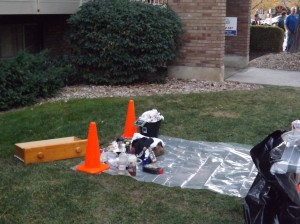Recent developments in the meth lab created just off BYU campus have raised a lot of questions, but you don’t have to cook your own meth to find out how to spot it. Here are some quick facts about meth so you won’t be blindsided.
How to spot a meth lab
You may be living near a meth lab if:

- There are unusual odors coming from the facility (ammonia — health officials describe the smell as “cat urine” or other chemicals).
- There are excessive amounts of trash, specifically chemical containers, pieces of cloth that are stained red, coffee filters and duct tape rolls.
- The curtains are usually drawn and the windows covered with aluminum foil or blackened on residences, garages, sheds or other structures.
- There is evidence of chemical waste or dumping.
- Visitors come frequently at unusual times.
- The residences take extensive security measures or attempts to ensure privacy (examples: “no trespassing” or “beware of dog” signs, fences, large trees or shrubs)
Meth facts
- Methamphetamine is a compound of acids, bases, phosphorous, ammonia, iodine, hydrogen chloride and other products containing pseudo-ephedrine.
- Potential health effects of exposure to chemicals used in a meth lab: nose and throat irritation, headaches, dizziness, nausea, vomiting, decreased mental function, kidney damage, birth defects, confusion and breathing difficulties.
- Meth was first used in WWII to keep soldiers on both sides awake during battles. It was also taken by Japanese Kamikazes before suicide missions.
- Contrary to popular belief, there is no official “meth capital,” but meth is a widespread drug becoming more and more popular throughout the United States.
- Symptoms of a meth user include irritability, aggressive behavior, anxiety, auditory hallucination, paranoia, violence and “meth mouth” (loss of teeth).
- Methamphetamine is a stimulant and is highly addictive. Meth affects the central nervous system by releasing high levels of dopamine into the brain that regulate feelings of pleasure.
- Methamphetamine is a pill or a powder. Crystal meth resembles glass fragments or shiny blue-white “rocks” of various sizes.
- Meth users abuse it through swallowing, snorting, injections and smoking.




